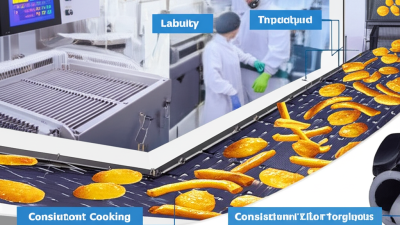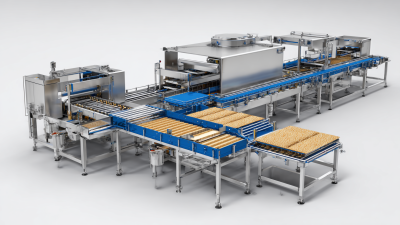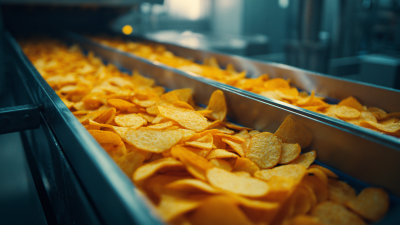How to Optimize the Efficiency of Your Egg Tray Washer
Table of Contents
- Identifying Key Features for High-Performance Egg Tray Washers
- Understanding the Importance of Regular Maintenance and Cleaning
- Optimizing Water and Energy Usage for Cost Efficiency
- Implementing Effective Loading Techniques for Maximum Productivity
- Leveraging Technology for Monitoring and Automation Enhancements
- Training Staff on Best Practices for Operation and Safety
- Enhancing Sanitation Efficiency: Insights from Industry Reports on Commercial Crate Washers and Their Impact on Hygiene Standards
- FAQS
- Conclusion
- Related Posts
In the busy world of food processing, making sure your machinery, like the Egg Tray Washer, runs smoothly is pretty much essential for keeping productivity high and quality standards up. If you’ve checked out the Food Processing Machinery Market Report, you’ll see that demand for smarter, more efficient cleaning solutions is on the rise — mainly because regulations around hygiene are tightening, and tech keeps evolving. Companies like Shandong Kexinde Machinery Technology Co., Ltd., are really pushing the envelope here, focusing on creating innovative equipment specifically for the food and beverage industry. As production lines get faster and bigger, using cutting-edge Egg Tray Washers can seriously cut down on water and energy use, which not only saves money but also helps the environment. Bottom line? Getting a good handle on how to optimize these machines isn’t just about efficiency; it’s also about staying ahead of the game with greener, more sustainable manufacturing practices.

Identifying Key Features for High-Performance Egg Tray Washers
When you're trying to get the most out of your egg tray washers, it’s really important to know which features actually make a difference in how well they perform. One of the biggest things to look at is how much water they use—since efficient models are designed to cut down on water waste but still do a great job cleaning. You’ll find that things like advanced spray nozzle tech and smarter washing cycles that adjust based on how dirty the trays are make a real difference here.
Another thing to consider is how automated the washer is. The more it can handle on its own, the better — it means less manual effort and can save you some bucks on labor. Devices with smart sensors that keep an eye on water temperature and detergent levels are gold because they help keep the cleaning steady and avoid wasting resources. And of course, durability and how easy it is to do maintenance on your machine really matter over the long run. A sturdy build and easy-to-access parts mean less downtime and lower upkeep costs. Focusing on these key points will definitely help you get the most out of your egg tray washer and keep things running smoothly.
Understanding the Importance of Regular Maintenance and Cleaning
Keeping your egg tray washers in tip-top shape isn’t just a good idea — it’s pretty much essential if you want them to work efficiently and last longer. I recently read a report from the International Egg Commission, and it pointed out that facilities that stick to regular maintenance routines actually see their breakdowns drop by as much as 30%. Crazy, right? It really highlights how important it is to do routine check-ups on those mechanical parts, water systems, and filters. Skipping these steps not only costs more in repairs later on, but it can also slow down production — no one wants that.

And let’s not forget about cleaning. Regular cleaning of the egg tray washer is key to keeping everything hygienic. The USDA stresses that consistent cleaning cycles don’t just prevent bacteria from piling up; they also help the machine perform at its best. Apparently, washing machines that get a thorough clean every month can boost their efficiency by nearly 15%. That’s a pretty noticeable difference! Plus, it’s not just about good hygiene — it’s about making sure your operation meets strict food safety rules, which are only getting tighter these days. So, all in all, taking care of maintenance and cleaning isn’t just good practice — it’s a smart move for smoother, safer, and more efficient egg production.
Optimizing Water and Energy Usage for Cost Efficiency
When it comes to egg tray washers, finding ways to save water and energy is a big deal if you want to keep costs in check. One smart move is setting up a recirculation system. Basically, you gather the rinse water and reuse it—that way, you’re cutting down on waste and saving on water bills. Plus, adding sensors to keep an eye on water levels can help make sure you're not using more than you need, avoiding unnecessary overflows or wasting water.
On the energy front, upgrading to newer washing machines that are designed to be energy-efficient makes a big difference. Machines that can sanitize at lower temperatures still do the job, but they sip less power, which adds up over time. Also, planning your washing cycles during off-peak hours can help save on energy costs when demand is lower. Honestly, combining these tweaks doesn’t just save some cash — it’s also better for the environment and helps your operation run smoother overall.
Implementing Effective Loading Techniques for Maximum Productivity
Getting the loading process right is pretty important if you want your egg tray washer to work its best. Think of it like tuning up a machine or optimizing energy systems — when you load trays efficiently, everything runs smoother and faster. If you spread out the trays properly during loading, you help the machine hit its maximum capacity, meaning less downtime and more trays cleaned in less time.
You can even borrow ideas from multi-objective optimization—things like choosing the right spots for capacitor banks or big solar setups. By looking at how your trays are loaded over time and tweaking the arrangement, you can prevent blockages, improve water flow, and end up with much cleaner eggs. And the best part? If you keep an eye on how things are going and make small adjustments along the way, you'll keep boosting the washer’s performance. It’s all about finding that sweet spot where everything runs efficiently and produces top-notch quality. Feels more like a conversation, right?
Leveraging Technology for Monitoring and Automation Enhancements
In today’s fast-moving world of manufacturing, using technology to keep an eye on and automate the egg tray washers is pretty much essential for getting things running smoothly. Stuff like adding smart sensors into the washing machines lets you see in real-time how things like water temperature and detergent levels are doing—plus tracking the overall performance. This kind of data-driven setup doesn’t just boost cleaning quality; it also helps catch potential issues early, sending alerts for maintenance before things break down entirely.
Automation also makes a big difference. Stuff like automated loading and unloading can really speed up the process, cutting down on manual work and reducing those pesky human errors. Plus, with programmable logic controllers (PLCs), you can tweak the washing cycles to match different tray types, which means cleaner trays and less wasted resources. All these tech upgrades really work together to make the whole egg tray cleaning process more reliable and efficient. In the end, that means more productivity, happier customers, and some nice savings for the business.
Efficiency of Egg Tray Washer Over Time
Training Staff on Best Practices for Operation and Safety
Training your staff on the best ways to operate egg tray washers isn’t just a good idea — it’s pretty much essential for keeping things running smoothly and safely. When people know what they’re doing, it’s not only about getting the job done efficiently, but also about cutting down the chances of accidents happening, which can really cause big problems. I read somewhere that companies that put effort into thorough safety training actually see about a 50% drop in workplace incidents. That really shows how worth it investing in proper training can be — making the workplace safer and way more productive at the same time.
On top of that, building a safety-first culture with ongoing education makes a huge difference. It genuinely empowers employees, giving them the confidence to make smart decisions while they work. For example, in manufacturing setups, those that hold regular safety briefings and hands-on training seem to be way better at handling emergencies — like, up to 40% more effective. With all the new tech and best practices popping up in egg tray washing, it’s more important than ever that workers are trained well enough to keep up. That way, they stay safe and the operation stays efficient and on point.

Enhancing Sanitation Efficiency: Insights from Industry Reports on Commercial Crate Washers and Their Impact on Hygiene Standards
In the pursuit of enhancing sanitation efficiency within the food and beverage industry, adopting advanced commercial crate washers is crucial. Our crate washer stands out as a pivotal tool for businesses aiming to uphold high hygiene standards while also streamlining operations. Built with durability and reliability in mind, our machine is designed to endure the rigors of daily use in bustling production environments. Its robust construction ensures that businesses can rely on it day in and day out to maintain cleanliness without compromising on performance.
Moreover, the efficiency of our crate washer directly translates into significant cost savings. By thoroughly cleaning crates in a fraction of the time, it reduces labor costs and minimizes downtime associated with manual cleaning processes. This machine not only meets but exceeds stringent hygiene requirements, thereby safeguarding both employee safety and product integrity. Additionally, its user-friendly design simplifies operation and maintenance, making it an ideal solution for companies of varying sizes. By integrating our crate washer into your operations, you can enhance productivity, minimize waste, and cultivate a safe, sanitary workplace for your staff.
FAQS
: Regular maintenance is essential for optimal efficiency and extending the lifespan of egg tray washers. It can reduce breakdowns by up to 30% and helps avoid costly repairs while improving production efficiency.
Egg tray washers should ideally undergo thorough cleaning every month to prevent the buildup of bacteria and enhance operational efficiency.
Regular cleaning can improve the operational efficiency of the washers by nearly 15% and ensures compliance with food safety regulations, which is crucial in the egg production industry.
Neglecting maintenance increases the likelihood of breakdowns and costly repairs, while also negatively affecting production efficiency.
Effective loading techniques can maximize productivity by ensuring efficient distribution of egg trays, minimizing downtime, and maximizing throughput during the washing process.
Principles from multi-objective optimization, such as analyzing load patterns and adjusting tray arrangements, can help eliminate bottlenecks and improve water flow for better cleaning results.
Continuously monitoring and adjusting loading techniques based on operational feedback can optimize the performance of the egg tray washer, leading to improved quality and efficiency.
Regular cleaning cycles of egg tray washers are necessary to maintain hygiene standards and prevent the buildup of bacteria, which is crucial for food safety.
By prioritizing maintenance and cleaning, businesses can achieve higher operational efficiency and compliance in their production processes, which is vital in the egg production industry.
Efficiently arranging the trays during loading can improve water flow and lead to better cleaning outcomes, thereby enhancing the performance of the egg tray washer.
Conclusion
If you want to get the most out of your Egg Tray Washer, there are a few key tricks that can really make a difference—both in how well it works and how much you end up spending. First off, it’s all about spotting the must-have features, like strong cleaning systems and energy-saving parts. Don’t forget, keeping the machine clean and well-maintained is super important—it helps it run smoothly and lasts way longer. Oh, and being smart about water and energy use can save you a pretty penny in the long run.
When it comes to loading trays, doing it efficiently can really bump up productivity—you want those trays to get cleaned properly without slowing things down. Using the latest tech for monitoring and automation can also speed things up, cut down on manual work, and make everything run more smoothly. And of course, training your staff on how to operate everything safely and correctly is a must—no shortcuts here! At Shandong Kexinde Machinery Technology Co., Ltd., we’re all about providing top-tier equipment that’s tailored for the food industry, including state-of-the-art Egg Tray Washers built with these tips in mind.
Related Posts
-

Advantages of Conveyor Belt Frying Machines for Efficient Food Processing
-

Maximize Your Investment with Exceptional After Sales Support for Best Crisp Chips Making Machine
-

Leading the Way in Export Strength: The Best Chicken Basket Washing Machine from China
-

Ensuring Quality Standards in the Best Chips Fryer Machine Production for Global Buyers
-

How to Efficiently Set Up Your Chicken Nuggets Processing Line for Global Success
-

5 Essential Tips for Optimizing Your Frying Production Line Efficiency


